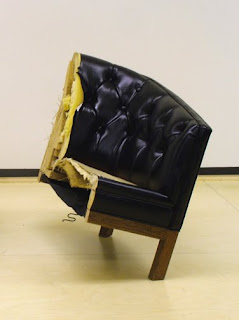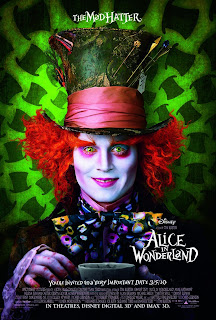I didn't spend enough time in any one place this year to claim to present a synopsis of a region's best, but I did, in my wanderings, see a good deal of good art. (Mostly I was in Seattle.) Some have been praised already, both on this blog and off, and some I would be remiss if I let the year pass without giving them mention. So before the date turns, here are the best new things I came across in 2010, in no particular order.
A Tool To Deceive And Slaughter

Early in the year I walked past a well-made black box in Seattle's Lawrimore Project and couldn't be bothered to examine it more closely. It was clearly related to Robert Morris's Box with the Sound of its Own Making, a fixture in Seattle Art Museum's Minimalism gallery, but the night was wearing on and I was eager to make my way home. Mistake. Only later did I learn in The New York Times Magazine that this piece by Caleb Larsen actually tries to sell itself on eBay . . . all the time. All the time? Yes. Once someone buys it, A Tool to Deceive and Slaughter sets up a new auction with a newly revised opening bid, and the owner is required to send the piece along once sale is made. A hilarious take on the consumerism that is the art market, I bid Larsen's Tool Godspeed in repeatedly raising its own price into perpetuity — or not — and pointing out one of the absurdities that has been made of art in our time.
Untitled (Shit Happens)
Another irreverent favorite, found in Indonesia, was Malaysian artist Ahmad Fuad Osman's presumably operational blender serving as home to a fish and a water plant. I hate to heap praise on an art star, but Untitled (Shit Happens) was so blunt, so cocky, so absurd, and so unsettling, I can't help but mention it again. The very real possibility of so easily snuffing out an unsuspecting, if inconsequential, little fish — and the neon letters seemingly taunting you to do so — is a surprisingly disturbing prospect. It's the kind of thing that makes people object. 'This isn't art!' (Notice it's not about the fish.) But it knows, and it loves it, and it is.
Love Fear Lust Pleasure Pain Glamour Death

Also previously mentioned was Seattle Art Museum's staging of Love Fear Lust Pleasure Pain Glamour Death, a selection of photographs and short films by American master Andy Warhol. What was refreshing about this show was how much the museum stood back, and allowed the work to just be on display. Then of course, the work was powerful and enthralling all on its own. And in what ended up the humblest of curtain calls, Dennis Hopper's Screen Test was made more poignant with the coincidence of his death.
Chuck Close Prints

In the other Washington, another American master. There's nothing surprising about a collection of Chuck Close's work coming off as impressive, large as it tends to be, but what was most impressive about Chuck Close Prints at the Corcoran Gallery was its deep insight into the art and process of printmaking. I worried at first that it would be instructive like that time Bobby Jindal talked to us all on national television, but the museum assumed no stupidity in its audience, and managed to present printmaking from its fundamentals to a number of elaborate and unconventional processes in a way that was both interesting and understandable — and not patronizing. The lens of Chuck Close's oeuvre offered an ideal and commanding structure for this heavy undertaking.
Wall
A very different deconstruction of process could be seen in March at Seattle's Western Bridge. In a three-day performance, Corin Hewitt cut, removed, reinforced, rearranged, and otherwise fiddled with the inner and outer portions of gallery walls where he could be observed both directly within the gallery and by closed circuit video from the outside. I preferred the video, in which objects became suddenly not themselves when they were revealed to be photographic reproductions, or stacks of the like, and photographs became objects as the mind lost track in the jumble. Unsurprisingly, it's not really about the wall.
A Dirt Crown Worth Its Weight

Continuing a tradition of good work, Bryan Schoneman staged a thesis performance in the University of Washington's 3D4M Gallery in which he operated an oversized machine built solely for the purpose of pouring dirt onto his head. Schoneman may contradict me on this, but I'm convinced it's not really about the dirt. Instead, The Dust Settles seemed to be about the slow, eerily peaceful atmosphere arising from the artist's bizarre, trivial exertion. In either case, it later won an award. (Congratulations.) With any luck, galleries will learn to accommodate the mess so more of us can see Schoneman perform in the future. And if they don't, they'll miss out, because I'm sure he'll manage to find other venues.
Drawing Construction #2 (Shadow Boxing Compass)
The other highlight of the MFA season was Samuel Payne's installation and/or assemblage at the Henry Art Gallery's UW MFA Thesis Exhibition. (Full, if cryptic, disclosure: I was personally involved with this show.) Drawing Construction #2 (Shadow Boxing Compass) has been called overkill, but such is the specificity of Payne's language that this piece was anything but. Surely it was difficult to decipher, but Payne's work needs to be understood in the context of its past incarnations, and this piece built upon a personal iconography developed by the artist over the course of years. There were the paper covering that began on his studio wall, the shoes oriented maybe in cardinal directions to allude to his travels, the music stand from a number of previous pieces, the sound of chopping wood from — from who knows where. It's hard to be specific about this piece without being really specific, which is why I hope to write more about it in the future, if I can muster it. In the meantime, just envision a complicated conglomeration of recycled forms and works and memories.
Beat Memories
Speaking of memories, Allen Ginsberg took some photographs, and the National Gallery mounted an exhibition. If I am to mention a photography show, it would certainly be appropriate to include MoMA's first ever retrospective of Henri Cartier-Bresson, but we already knew he was a great photographer. Allen Ginsberg, the poet, was the more surprising. Plus, in addition to some darn good photography, each print included a hand-written caption of sorts, a little prose poem inseparable from the image, which added that much more richness to the experience. I'll let Ginsberg close us out, with the caption that stayed with me all the rest of the year.
I sat for decades at morning breakfast tea looking out my kitchen window, one day recognized my own world the familiar background, a giant wet brick-walled undersea Atlantis garden, waving ailanthus ("stinkweed") "Trees of Heaven," with chimney pots along Avenue A topped by Stuyvesant Town apartments' upper floors two blocks distant on 14th Street, I focus'd on the raindrops along the clothesline. "Things are symbols of themselves," said Chögyam Trungpa Rinpoche. New York City August 18, 1984
Allen Ginsberg




















